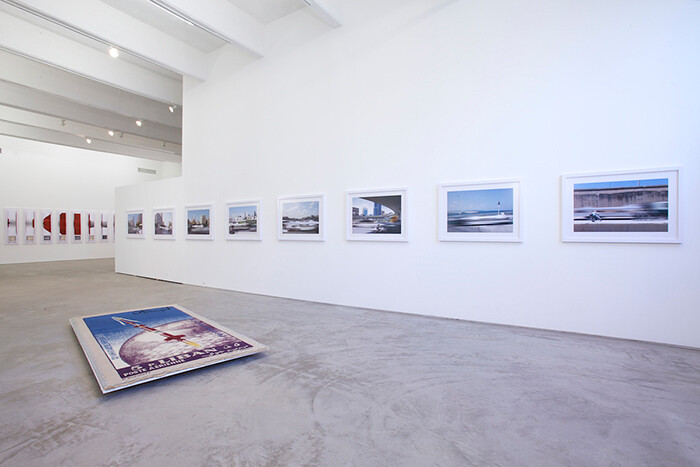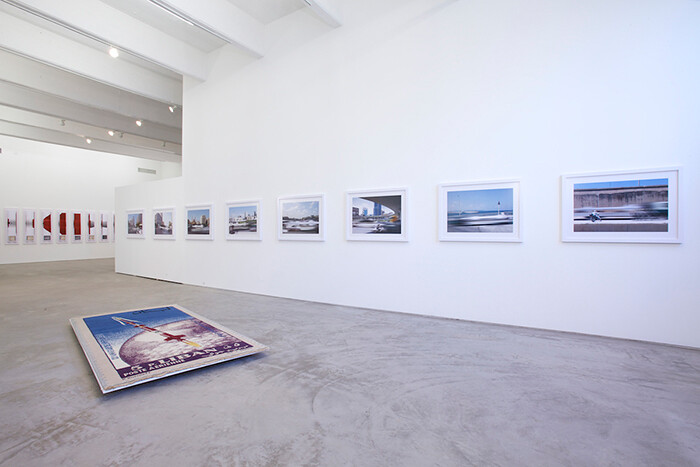Much to their surprise, Joana Hadjithomas and Khalil Joreige recently came across a half-century-old Lebanese postage stamp depicting a rocket emblazoned with a cedar tree. Though enshrined in official history, this inscrutable, fantastic image—seemingly the stuff of science fiction—commemorated an event no one could remember. An enigma, it intrigued the artists enough to do some research. They discovered that between 1960 and 1967, as the global superpowers vied for superiority in the space race, Armenian students at Beirut’s Haigazian University had successfully produced the Middle East’s first rockets intended for space exploration. The Lebanese Rocket Society launched more than ten of what were called “Cedar” rockets (after the country’s national emblem), reaching an altitude of two hundred kilometers with the “Cedar IV” rocket and briefly becoming the pride of a small nation riding the hopeful, modernizing wave of pan-Arabism. The amateur space program fell apart in 1967, and later, with Lebanon besieged by sectarian strife, it was forgotten.
Like many Lebanese artists who came of age during the country’s civil war (1975–1990), a period excluded from national textbooks to this day, Hadjithomas and Joreige have investigated—and invented—unofficial histories both to redress public amnesia and to question the select images and narratives that have endured. Like The Atlas Group (a fictional art collective, created by their peer Walid Raad, that has fabricated both protagonists and producers of its narratives), Hadjithomas and Joreige sometimes blur fact and fiction. Take their project Wonder Beirut (1997–2006), for instance, which posits a photographer who, in 1968, produced postcards showcasing Beirut’s luxurious beachfront. Seven years later he ostensibly seared the images—in precise correlation to real-life bombings—as war broke out. Wonder Beirut is a fantasy of a tormented, but cathartic relation between representation and reality, in which the commodified image is scarred in tandem with its referent. The actuality is more tragic: anachronistic postcards of a pristine, idealized pre-war Beirut continued to be sold after many of the buildings they depicted had been destroyed. Displaying the postcards as a series of disfigured prints and burnt negatives by the “pyromaniac photographer” Abdallah Farah, Hadjithomas and Joreige—like Raad and other contemporary Lebanese artists—symbolize the devastation of the civil war from an imaginary perspective, which becomes a necessary foil to the hollow position of official knowledge.
Though the history it charts has dissipated in collective memory, “The Lebanese Rocket Society: A Tribute to Dreamers” is entirely rooted in fact. Hadjithomas and Joreige construct a porous, layered narrative from actual events, opening the field of inquiry outwards from the Lebanese Rocket Society to its cultural context, while accentuating the spectral character this remote subject has acquired. In so doing, the artists generate traces of a past that cannot be historically integrated because it remains, in its fragmentary reconstruction, more potential than real. To be real again, they suggest, this past must first reenter the collective imagination, which has suppressed it since 1967—a “moment of disenchantment,” in the artists’ words, when revolutionary dreams of pan-Arab modernism were defeated.
The result of extensive research, the exhibition invites viewers to look and listen across layers and intervals, connecting, sifting, and unraveling. In The President’s Album (2011), photographic fragments of the “Cedar IV” rocket form an interrupted, to-scale model of the projectile across thirty-two panels, even as most of the rocket remains concealed beneath the folds of each image. Eight meters long yet irremediably partial, The President’s Album is less a monument than a symbolic testament to the chasms preventing this historical achievement from surfacing in the present.
Indeed, wary of nostalgia and triumphalism alike, Hadjithomas and Joreige guard against notions of monumentality. The artists produced a sculptural model of a “Cedar” rocket and donated it to Haigazian, where it now stands as a public tribute to the university’s forgotten space program; but rather than reproduce this model here, they reveal glimpses of yet another replica against the backdrop of Beirut’s streets. In order to transport what looked like a missile, they needed multiple authorizations and a police convoy; hence, requiring more time to document this passage, they restaged the action with yet another replica. The photographic series Restaged (2012) records their reproduced reproduction, an indistinct projectile coasting past a crisp background that has likewise undergone many stages of reproduction: Beirut’s gaudily reconstructed downtown.
The survival of the past, and its imperceptibility to the present, is also at stake with The Golden Record (2011), a twenty-minute sound collage accompanied by a video of a spinning gold disc. Inspired by a radio transmitter embedded in each “Cedar” rocket, as well as the time capsules that Americans sent into space with each Voyager mission, The Golden Record evokes the culture and politics surrounding the Lebanese Rocket Society. A radio news report on riots in Lebanon gives way to the iconic voice of Egyptian singer Oum Kalthoum; the hum of a British fighter jet intermingles with Gamal Abdel Nasser’s resignation speech.
The artists selected these sounds in conversation with people close to the Rocket Society, whose memories and affiliations likewise instigated A Carpet (2012). A wool rug depicting the 1964 stamp that led Hadjithomas and Joreige to their project, the piece is modeled after carpets produced by young Armenian girls in a Lebanese orphanage—in particular, a carpet they gave US President Calvin Coolidge in 1926, in gratitude for American support of their shelter and education outside Turkey. Among the children of these refugees, the artists learned, were students at Haigazian who took part in the Lebanese Rocket Society.
It’s just such interlinked acts of hope, idealism, and generosity that were once dramatically played out on the international stage that Hadjithomas and Joreige’s project excavates. Yet even as the artists pay tribute to dreamers—notably, Armenian refugees of genocide who dedicated themselves to the pursuit of art and science—they resist naïve laments for a lost age of peace and progressivism. Instead, they are dutifully engaged with the challenges of historical recuperation, chief among these being the privileged structures through which past events become visible, whether a web search—the most popular results being, in this case, reports on the latest rockets fired between Hezbollah and Israel—or a monument, which forecloses reappraisals, petrifying a single perspective. Hadjithomas and Joreige respond to these challenges with a paradox: by paying tribute to the dreamers of the Lebanese Rocket Society, it is necessary to recover their history as a dream, unraveling fugitive associations that are shaped by—but never bound to—subjectivity, time, and place.









